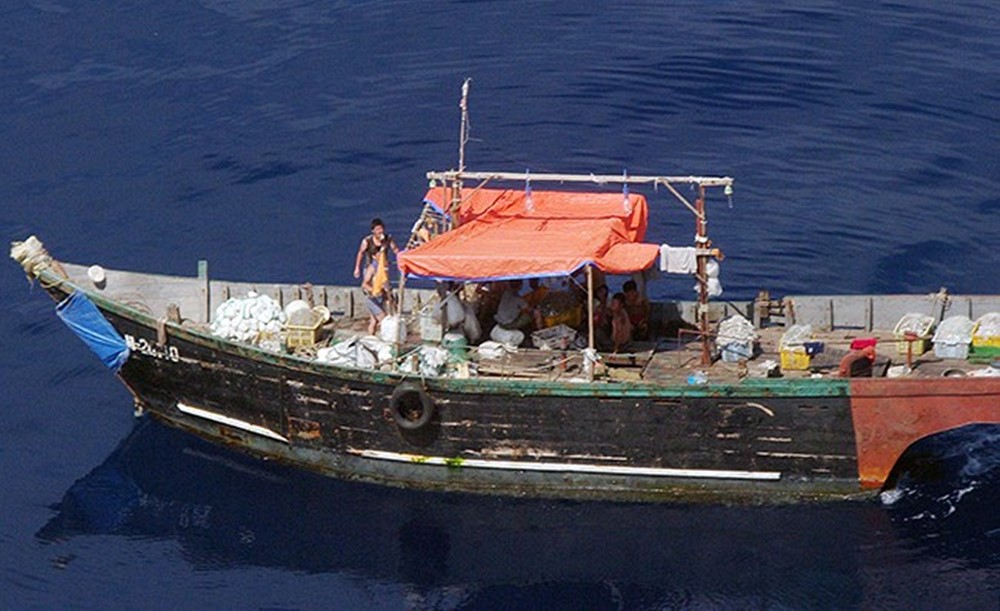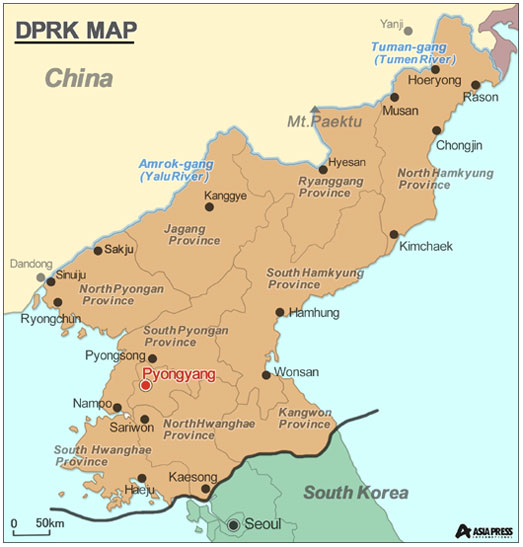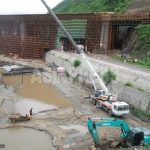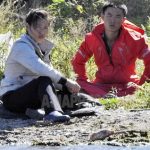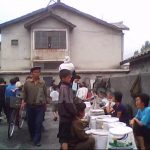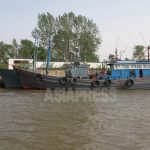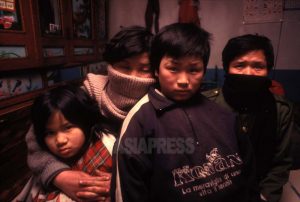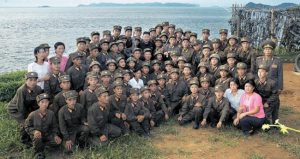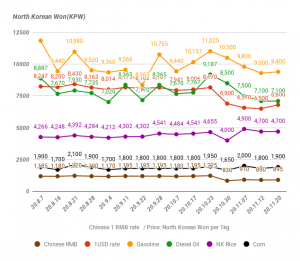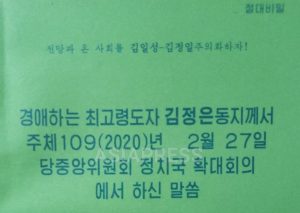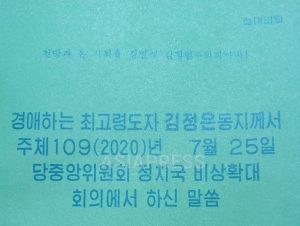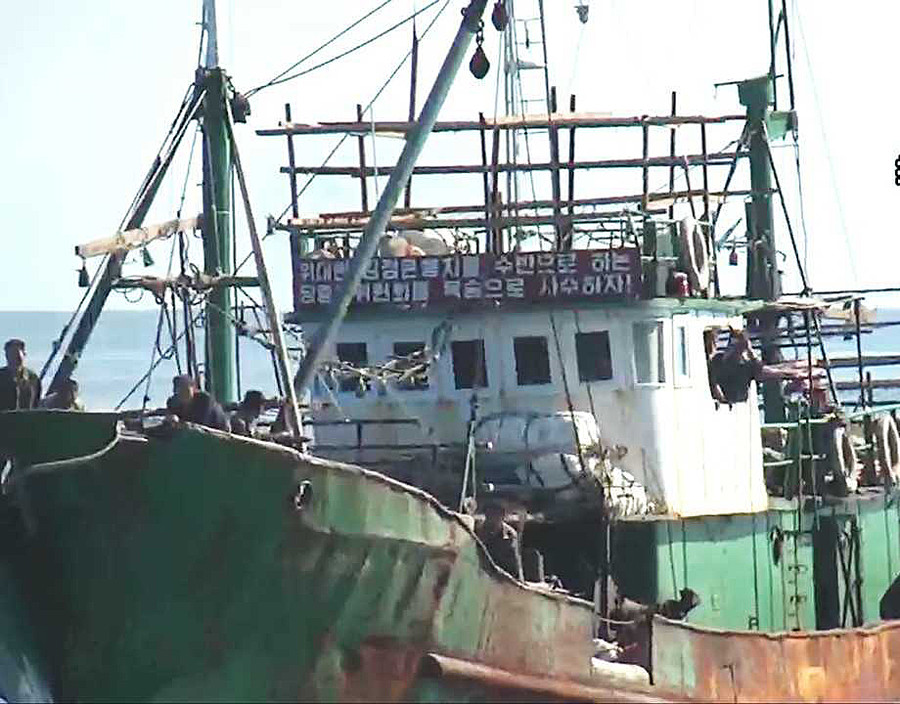
A large North Korean fishing vessel discovered near Japan’s EEZ. A slogan can be seen on the boat that says: “Let’s defend to the death the Party Central Committee, which is led by the Great Comrade Kim Jong-un.” Party officials also ride on fishing ships to keep everyone in line ideologically. Taken in 2019 by the Ogi Fishing Cooperative in Ishikawa Prefecture.
North Korea’s economy has begun to regain some of its footing following the end of the COVID-19 pandemic. The country’s fishing industry, which had been severely restricted for around three years over concerns that fishermen would import the virus, is also undergoing changes. What kind of situation is the industry facing now? From late November to early December, ASIAPRESS conducted a survey of the North Korean fishing industry using reporting partners inside the country. The results of the survey show that the COVID-19 pandemic, the Kim Jong-un regime’s various controls and restrictions, the skyrocketing of fuel prices, and the considerable shrinking of available fishing grounds, have led to the industry’s decline. The results of the survey will be explored over three installments. (KANG Ji-won / ISHIMARU Jiro)
◆ What was surveyed?
The survey involved reporting partners in North Hamgyung and Yanggang provinces exploring three areas: 1) the fishing situation in the East Sea region; 2) the state of transport and distribution of seafood; and 3) the cost of various seafood in markets. The reporting partners were unable to visit areas with seaports due to severe restrictions on their movement; however, they made domestic phone calls to people working in the fishing and seafood industries and met with local businesspeople involved in seafood sales. The survey was able to garner information about the situations in Chongjin, Kimchaek, Myongchon County, and Hamhung (South Hamgyung Province). The survey couldn’t gather information about the situation on the West Sea, unfortunately.
◆ How is the North Korean fishing industry structured?
North Korea’s fishing industry these days can be divided into four parts: 1) fishing collective unions; 2) state-run seafood companies; 3) seafood companies run by the military and trading companies; and 4) privately run fishing operations.
Fishing collective unions began with the collectivization of fishermen on the coasts. Fishermen who are part of these unions generally operate on small fishing boats.
State-run fishing companies generally use mid-sized to large-sized fishing boats to fish in areas far out at sea. Employees of these companies receive rations and salaries.
Companies run by the military and trading entities are focused on earning foreign currency and catching various kinds of seafood used in side dishes. Before the outbreak of COVID-19, these companies generally exported their products to China to earn money. Moreover, some companies were ordered by the government to provide food for side dishes at orphanages and elderly care facilities. The “January 18 Seafood Company,” which is run by the military, is one example of this, and its achievements are heavily promoted in state-run media outlets.
Finally, while privately-run businesses in their purest form do not exist in North Korea, people indebted to members of the wealthy entrepreneurial class (donju) build and operate small wooden fishing boats, which they register under the names of military and government agencies. The 2000s saw the rise of these kinds of businesspeople. Small wooden fishing boats that operated close to Japan’s EEZ are a good example of this. Boat operators acquire their own fishing equipment, engines, and fuel, and even the crew of the ships go out to sea on individual contracts. Agencies that lend their names to these private operators get 30-40% of the profits the fishermen make.
◆ The severe decline in fishing activities
Over the past three years since the start of the pandemic in January 2020, there is no doubt that North Korea’s fishing industry has faced great challenges. The biggest reason for this is that the North Korean authorities strictly restricted fishing boats from leaving port as part of efforts to prevent the virus from entering the country.
The health of North Korea’s fishing industry can partially be understood through data showing the number of “expulsion warnings” the Japanese coast guard has given to foreign ships entering the Yamato Bank fishing grounds, an area near Japan’s EEZ that is a key harvesting area for squid.
According to statistics from Japan’s coast guard, the number of warnings given to North Korean ships in 2019 was 4,007, while another 1,115 warnings were handed down to Chinese boats. However, in 2020, after the start of the pandemic, only one warning of the 4,393 handed out was given to a North Korean vessel. The rest were given to Chinese ships.
In 2021, the number of warnings given to North Korean ships fell to zero, but then in 2022, the number rose to 19 and, as of October 31, 2023, 24 warnings have been given out to North Korean ships (Over that same period, the number of warnings given to Chinese ships also fell drastically). The biggest reason for this fall in warnings was due to the North Korean government preventing ships from leaving port to fish. Another reason is likely the dramatic fall in squid available to fish in the Yamato Bank fishing grounds.
The Kim Jong-un regime shut down most of the trade flowing over the country’s borders immediately following the outbreak of COVID-19, which made it impossible for exports (in reality, smuggling) to continue. Moreover, the seafood restaurants that survived off Chinese tourists in Rason and other areas on the downstream of the Tumen River shut down completely when customers failed to show up anymore.
As this shows, even if fish are caught, they can’t be sold to many restaurants. The drastic fall in demand for seafood appears to have accelerated the decline in the fishing industry.
◆ Fishing industry still faces challenges even after COVID restrictions have eased
A seafood business owner in the East Sea coast told one of the reporting partners: “These days, pretty much the only ships operating are mid-sized to large-sized vessels owned by seafood companies and the seafood enterprises operated by government agencies. The smaller vessels operated by fishing collective unions and private businesspeople face so many challenges that they can’t go to sea.”
Private businesspeople operating small vessels have to undergo complicated and increasingly strict procedures to get their vessels out of port. For example, both fishing boat captains and their crew must be approved by the neighborhood watch units in their places of residence, the police, and the secret police. Military border patrol officials operate sentry posts at the entrances of ports, where boats are docked, which means that fishing boat crew may not be able to even board their vessels if they can’t get their documents approved.
The drastic fall in rich fishing grounds near coastal areas is also a major factor in the decline of North Korea’s fishing industry.
One reporting partner heard from fishermen that “China uses trolling ships to catch all of even the smallest types of fish, so there’s no more catch left in areas near the coasts. Fishing boats must venture far into the sea, but small wooden boats are severely restricted from leaving port because of so many incidents at sea in the past.”
The North Korean government has long sold rights to fish in its own EEZ to Chinese ships as a way to earn foreign currency. This is a violation of economic sanctions placed on the country by the UN Security Council. Now, North Korea’s fishing grounds close to shore have become depleted due to the government’s narrow focus on obtaining profits.
Accidents at sea refer to frequent discoveries of the wreckage of North Korean fishing boats on Japanese coasts from 2016 to 2018. This issue was even reported in the international media because so many horrible-looking corpses were found on the ships. Kim Jong-un, who lost face from the incidents, handed down an order in late 2018 to stop small ships from venturing far out to sea. The restrictions in place to prevent small ships from leaving ports are also aimed at preventing people from defecting the country through sea-based routes.
There are many people operating private fishing businesses whose operations have completely collapsed. “Many of the captains who enjoyed good earnings in the past have become so poor due to debt they are one step away from wandering around homeless. Fishermen who can’t go out to sea survive off the fish they catch through fishing on land and underwater; however, it’s hard for them to earn much that way,” the reporting partner said.
◆ Triple whammy: Lack of fishing equipment, no funds to repair ships, and skyrocketing fuel prices
The skyrocketing of international prices for oil has made things challenging for even seafood companies operating under government agencies.
“The government agencies don’t provide the companies with fuel, so they have no choice but to sell their catches to cover fuel costs. A lot of the time, there’s little business sense in them going far out to sea.”
Most North Korean mid-sized and large-sized vessels are extremely dilapidated as they were purchased second-hand from China and other foreign countries. There are no funds available to service them or purchase parts, and few of them can go out to sea because they require repairs.
Moreover, seafood companies under government agencies must fulfill quotas of seafood used for side dishes provided to the military, orphanages, and other facilities. (to 2 >>)
<Investigation Inside N. Korea> How is the country’s fishing industry doing? (2) Distribution of seafood faces challenges due to severe government restrictions…Why are private businesspeople unable to distribute their goods?
<Investigation Inside N. Korea> How is the country’s fishing industry doing? (3) Prices of eight kinds of popular seafood in 2 cities
- <Investigation Inside N. Korea> How is the country’s fishing industry doing? (1) COVID and shrinking fishing grounds major problems…Kim regime’s restrictions on fishing lead some fishermen to financial collapse
- <Inside N. Korea> The government distributes coal as winter sets in…, but only 15% of what people need…Robberies of firewood and coal are common
- <Inside N. Korea> The Major Changes Surrounding the November 26 Elections(1) For the first time, multiple candidates on secret ballots for preliminary election…a small change in past elections
- <Inside N. Korea>Speaking to a Border Guard (1) Landmine Burial at the Korea-China Border? “Even soldiers are afraid because they don’t know where they’re buried”
- <Inside N. Korea> A recent report on conditions at farms (1) The harvest is better than last year, but lack of materials remains a serious problem (4 recent photos)
